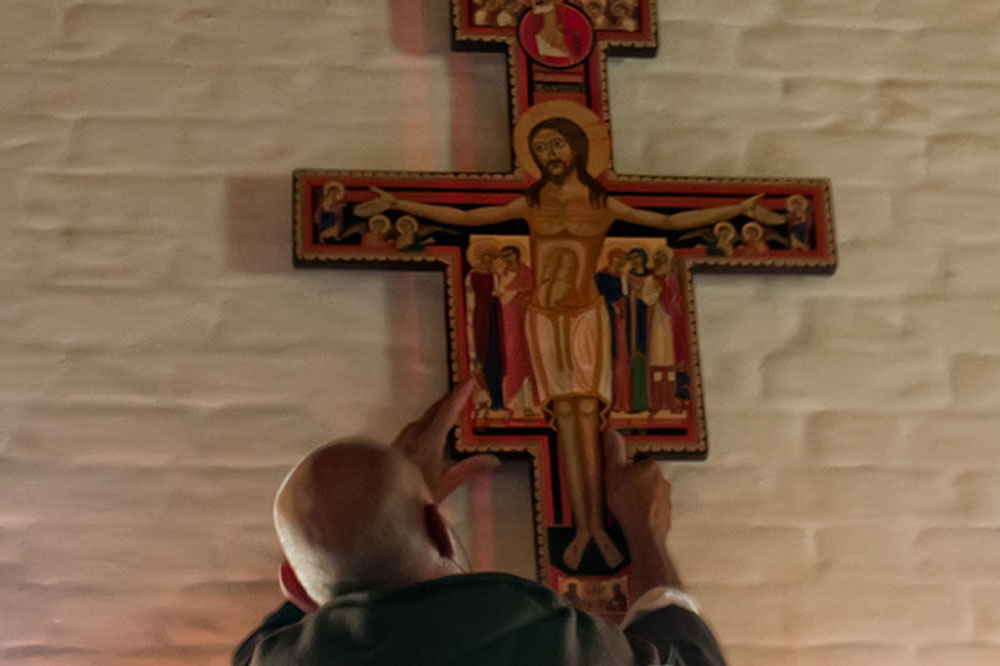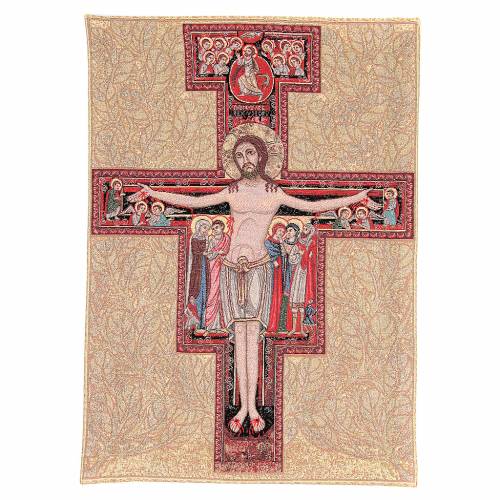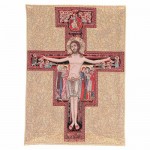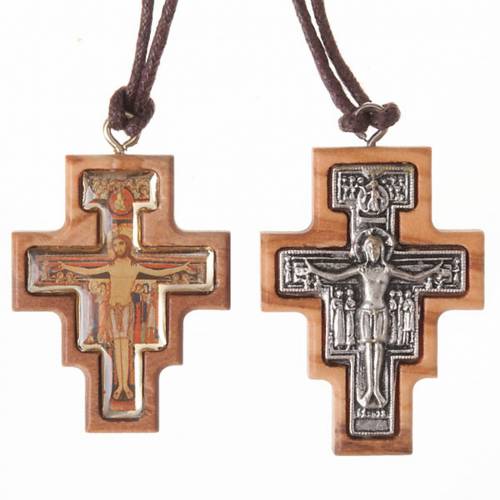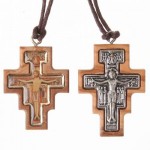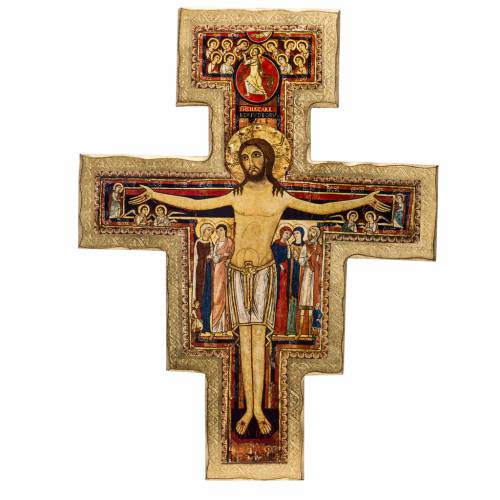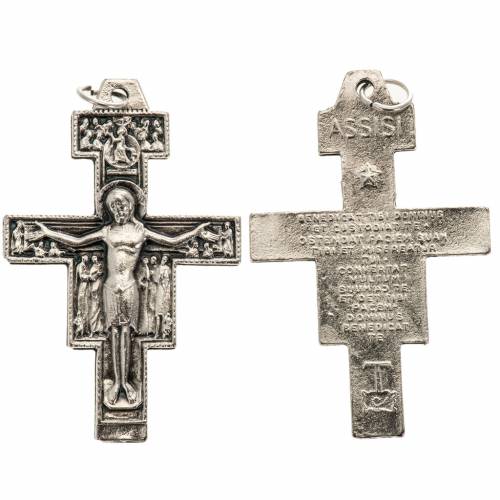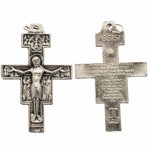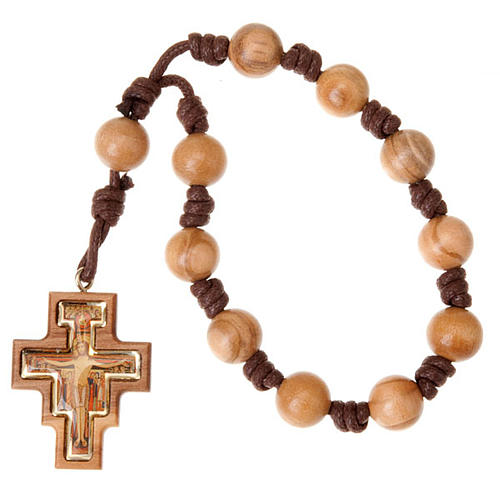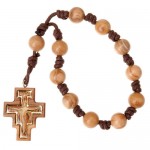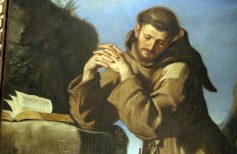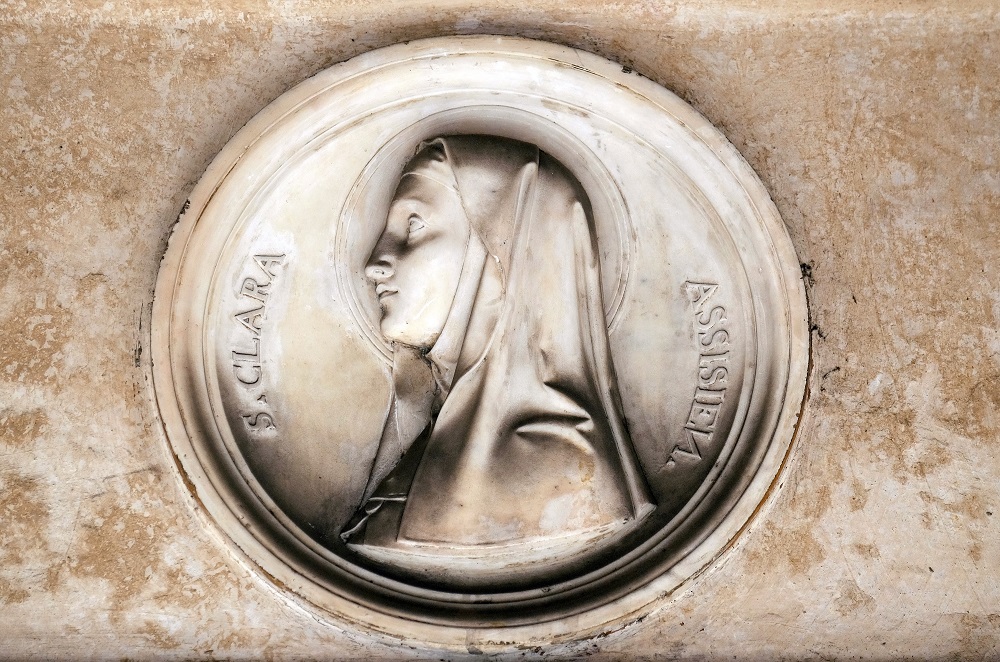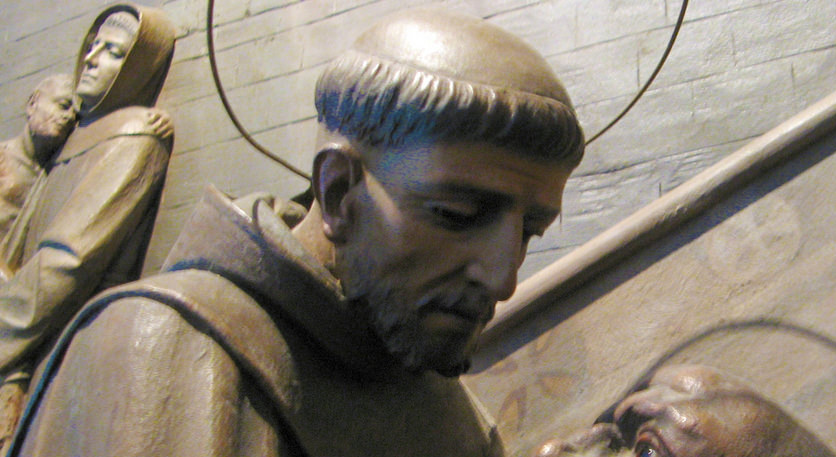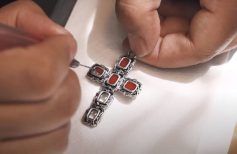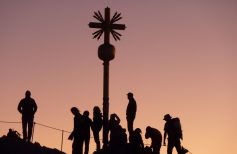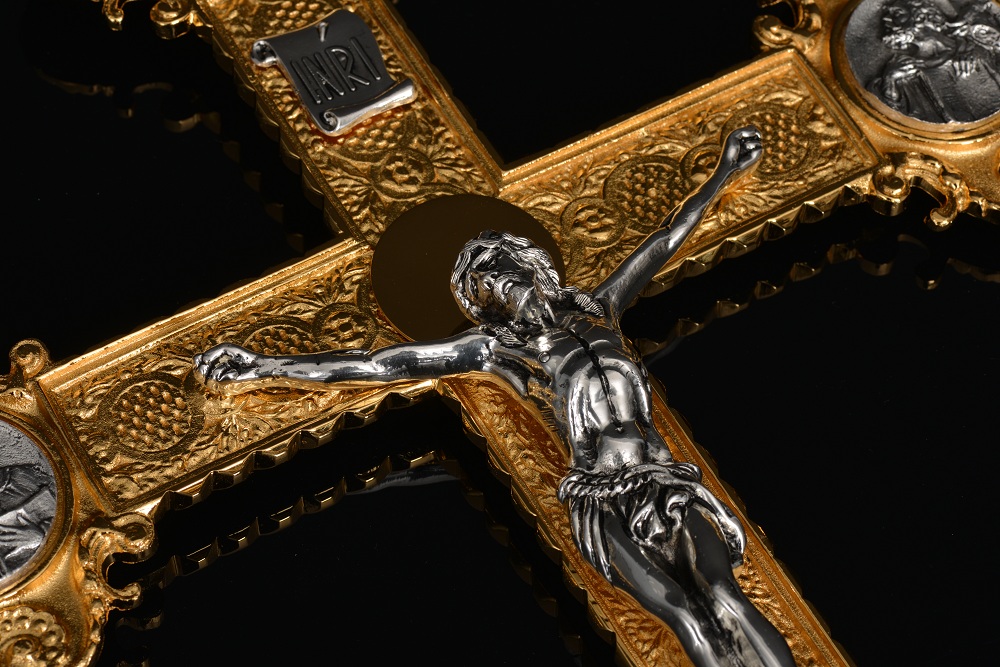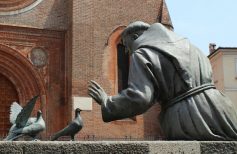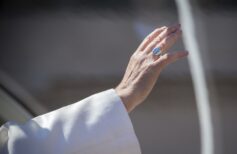The Crucifix of San Damiano is the one in front of which St. Francis was intent on praying when, in the distant year of 1205, he received from the Lord the call to work to restore his church. The Saint of Assisi believed at first that the Most High was referring to the church of San Damiano, where he was at that time, and that he needed a restoration work, but later realized that your request included the Church, ravaged by decadence, corruption, internal struggles. “Go and repair my house, which as you can see is all in ruins” were in fact the words that the crucifix addressed to the very young saint.
Today the Crucifix of San Damiano is an image famous all over the world, the goal of a constant pilgrimage by the thousands of faithful who go to Assisi each year. Originally located in the church of San Damiano, it is now exposed at the monastery of Santa Chiara, where it was transferred in 1275.
But what makes this sacred image so special? Certainly a large part of his celebrity comes from Saint Francis of Assisi and from the mystical experience linked to the Crucifix of San Damiano that involved him, but this particular representation of Christ triumphant on the cross existed long before the eyes of the poor Assisi set themselves on it. In fact this type of cross, which strongly recalls the Byzantine icons, is born with the Eastern Church and arrives in Italy and in Umbria through a long and adventurous journey.
But let us proceed one step at a time.
Who was San Damiano?
Damianus, or Damian, was a young doctor of Arab origin, born in the city of Aegean or Aigai in Cilicia (today known as Ayas of the Armenians, Turkey) and lived in the III century AD in what was then known as Roman Syria. It belonged to a family of five brothers: Cosma (according to modern scholars the twin of Damiano), Antimo, Leonzio and Euprepio. The identity of the father is unknown, even if it seems to be a Christian who suffered martyrdom still very young. The mother, Toedora, or Teodata, later sanctified in turn, raised the five children by herself. Because he belonged to a wealthy family, he was able to guarantee them a good education, so much so that all five began a career as a doctor, but, above all, being a deeply religious and devoted woman, he educated them to the love of God. Damian and his brothers studied in Syria and probably in Alexandria, at the schools of Theophrastus and Galen. Their being Christians marked their fate irremediably: they were all martyred, presumably during one of the persecutions promoted by the emperor Diocletian (284 – 305). The legend tells that, arrested by the prefect of Cilicia, Damiano and Cosma were first stoned, then flogged, crucified and targeted by darts. But the stones rebounded on them, hitting the soldiers, and the tips of the arrows and spears did not scratch them. Then they were thrown into the sea tied to heavy boulders, but the ropes that held them melted, and they were saved. Then they were chained and locked in a furnace, but not even the fire licked them.
Eventually all five brothers were beheaded in the city of Cirro, near Antioch of Syria. A less fanciful tradition speaks of arrest, torture and death by decapitation under Diocletian.
Their worship began immediately after their death. Throughout the East churches and sanctuaries dedicated to them were erected, and rapidly reached even the West, and Rome. As early as the 6th century, the Canon of the Mass recalled after those of the Apostles the names of twelve martyrs, including Cosmas and Damian.
In addition to martyrdom, it was also the virtuous life to assign these special brothers to the Holiness.
They used to treat the needy without asking for anything in return, according to the Gospel precept: “Gratis accepistis, gratis date” “for free you received, free dates “ (Mt 10.8). This had earned them the nickname of anàrgiri, or Anargyroi (from the Greek Ανάργυροι, “without silver”, “without money”).
Only once did Damiano accept between eggs from a woman who had healed, and this gesture offended his twin Cosma to the point of asking him that, once dead, his remains were laid far from those of his brother.
The medical activity allowed Damiano and his brothers to come in contact with many men and women, and to preach the word of God to them. There were many conversions made by the five brothers, and it was also what triggered the persecution of the Emperor on them.
We call the cult for Damiano and his brothers, in particular Cosma, the cult of “medical saints”, venerated by all the Christian professionals, considered the protectors of Doctors, Surgeons, Pharmacists and Hairdressers.
Eventually Cosma and Damiano were buried together, after a camel acquired the gift of the word only to defend the good intentions and the good faith of Damiano himself in the matter of the three eggs. The two older brothers immediately began to be worshiped as healers and thaumaturges, and their relics, considered miraculous, began to travel between East and West, throughout the known world, hosted by cathedrals and basilicas in Constantinople, Rome, Jerusalem, Madrid, Monaco, and in Egypt. Traditional iconography always represents them together, with their medical instruments, their vases of ointments and pharmaceutical remedies, and the palm of martyrdom. The Catholic Church celebrates their memory on September 26 with optional worship, the Orthodox one on July 1st, October 17th or November 1st.
Crucifix of San Damiano
Let us now come to the Crucifix of San Damiano, before which Francis of Assisi gathered himself in prayer on that day which changed his life forever.
As we have already written, it is a cross-icon in Byzantine style, probably painted in the twelfth century by a Syrian monk. Jesus, despite being on the cross, does not appear suffering, but triumphant, like a king on the throne, according to the typically medieval iconography of Christus triumphans. As always happens when we speak of Byzantine art, the beauty of the work does not reside so much in the aesthetic confirmation of the same, which offers rather a certain anatomical disproportion and a dimension that some have defined caricatured, or comic, of the figures. The beauty of this crucifix, probably one of a series painted at that time by the mysterious artist, expresses a powerful spirituality, a solemnity that cannot be grasped with a superficial glance. Everything is structured in a meticulous way, in its apparent naivety, everything occupies the space that belongs to it, in a framework where one breathes the inspiration of the divine Triumph.
Jesus is wounded and dying, yet he never appeared so strong. He triumphs over death, confronts him with his head held high, with his eyes open, great, immense compared to the other figures that populate the background. It is depicted with a kind of golden thong around the flanks, of Egyptian derivation, probably, which symbolizes His being, at the same time, high priest and sacrificial victim. On your head the halo looks like a golden crown, her hair is neat, her face expresses nobility, beauty, serenity. It’s true, his eyes turned to the sky they appear perhaps too big, out of proportion to the face, but the meaning that they want to express is clear: He is the one who more than everyone can see, who looks at Heaven and at the Father for us all. On his head there is the writing Ihs Nazare Rex Iudeorum, or “Jesus of Nazareth King of the Jews”. Even higher, a medallion it shows Jesus ascending to heaven, surrounded by angels in glory, and above him the blessing hand of God the Father.
Returning to the crucifix, there is one on Jesus’ forehead dove that swoops with wings spread, symbol of the Holy Spirit.
The image of Jesus is enclosed in a frame made of shells, which follow the contours of the cross and symbolize beauty and eternity.
The characters at base of the cross are not distinguishable: it could be, according to some scholars, the patrons of Umbria, or San Damiano, patron of the church that housed the cross, San Ruffino, patron of Assisi, and then San Michele, San Giovanni the Baptist, San Pietro, and St. Paul, all patrons of churches in the area of Assisi. Like all the other characters in the work are much smaller than the figure of Jesus.
Some scholars speak of subliminal messages hidden in the painting, details that the eye does not grasp, at a first superficial glance: on the chest of Jesus one can glimpse the head of a character, perhaps God Almighty, traced with the watermark, and another not better defined figure.
The hands of Jesus dripping blood on two mirror-like pairs of angels located under His arms. The angels on the right and on the left are the angels Messengers of God, who look at the stigmata with serenity and participation, discussing among them the mystery that is being consummated.
A third and a fourth figure they close each arm of the Cross with their own bodies, perhaps two evangelists, or two apostles, or perhaps the Jewish people and the ‘gentiles’.
Under the right arm of Jesus, bigger, there are Mary, and the Apostle John. The two look at each other, smile at each other, pointing to Jesus, who, by the will of the latter, have become mother and son: “Woman, behold your son …” (Thurs. 19/26 Mary has her left hand resting on her cheek, while with her right hand she points to Giovanni. She is dressed in white, a symbol of purity, of deep red, color of love, and of purple, with a reference to the fabrics that are said to line up the Ark of the Covenant. Her garments are quilted with precious stones, which symbolize the virtues. John is dressed in pink, the color of eternal wisdom, and white, a sign of purity.
Under the left arm of Jesus three other figures: Mary Magdalene, Mary mother of James and the Centurion. As for Maria and Giovanni, these figures also have their name shown below, under their feet.
Mary Magdalene dressed in red, color of love. She and Mary, mother of James, touch each other’s foreheads, as if something were whispering.
The last figure on the left, representing a bearded man dressed in white and red, would represent the Centurion whose son Jesus healed, leading to the conversion of the whole family.
Two smaller characters are symmetrically located in front of Mary and the Centurion: the one on the left is a Roman soldier, Longino, who pierced Our Lord’s chest and brought out water and blood; the other is placed in the same position, but does not seem a Roman soldier, but rather a Jew. It could also be Stephen, the Roman soldier who made Jesus drink the vinegar with the sponge, but it is more probable that the two figures symbolize the two peoples who condemned Jesus to death, Romans and Jews.
Next to Jesus’ left leg there is a cock, symbol of the sun that is born, or of Jesus himself rising from the dead.
The crucifix of San Damiano remained in the church of the same name renovated by Francesco, for forty years, guarded by Santa Chiara and her sisters. A few years after the death of the Saint, the nuns moved the monastery inside the city walls, where the basilica of Santa Chiara was erected. They brought with them the Crucifix of San Damiano, which is still there, in a chapel. A copy has remained in the church of San Damiano.
Our crucifixes of San Damiano
On our store you will find a wide range of reproductions of the Crucifix of San Damiano, both for support, both to hang and to wear around the neck. Most of them are handcrafted in moulded wood, and are available in various sizes.
There is also a splendid tapestry version with an exclusive design, with a refined Jacquard weave and satin-lined. A special pocket for the insertion of the rod will make it possible to hang it and display it. There are crucifixes of San Damiano pendants, made of Assisi olive wood, silver or coloured. An alternative to the wooden pendants are the silver-plated pendant crucifixes with engraving on the back. The Crucifix of San Damiano can also be the heart of a Rosary with grains in light brown oval wood and dark brown silk binding, made up of many knots, light and simple. Below we present the products described, available on our site!

